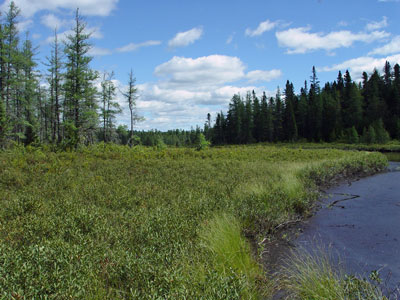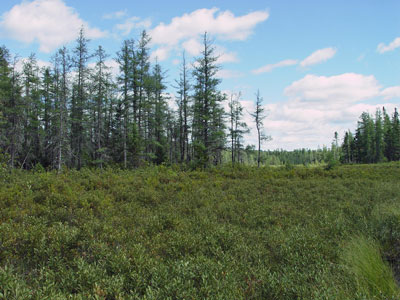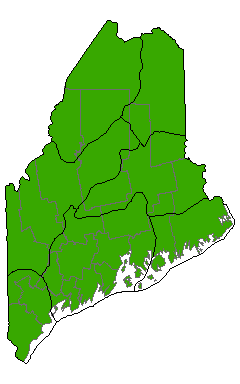DACF Home → Bureaus & Programs → Maine Natural Areas Program → Communities, Plants, and Animals → Natural Community Fact Sheets → Sweetgale Fen
Printer Friendly Fact Sheet - 880 KB pdf (Get a free copy of Adobe Acrobat Reader)
Sweetgale Fen
Scientific Name: Sweetgale Mixed Shrub Fen; State Rank: S4.

- Community Description
- Soil and Site Characteristics
- Diagnostics
- Similar Types
- Conservation, Wildlife and Management Considerations
- Distribution
- Characteristic Plants
- Associated Rare Plants
- Associated Rare Animals
- Examples on Conservation Lands You Can Visit
Community Description: A mixture of shrubs, typically about 1 m high (generally taller than bog shrubs, but shorter than most alder thickets), is dominated by sweetgale, leatherleaf, and hardhack or meadowsweet. Alder is usually present but not dominant. Graminoids, typically slender sedge, tussock sedge, and/or bluejoint grass, are usually mixed with the shrubs but are less abundant (averaging around 20% cover). Where shrubs are dense, herb cover is very limited. The bryoid layer is usually very minor; when present it is dominated by peat mosses. Back to top.

Soil and Site Characteristics: These basin wetlands occur either as part of larger peatlands bordering open water or in impounded areas with peat or muck soils (e.g. beaver flowages). Slow moving open water usually borders this vegetation. The substrate is seasonally to semi-permanently flooded organic material. Back to top.
Diagnostics: This type has a dominance of medium-height shrubs of sweetgale, meadowsweet, and leatherleaf. Graminoids are present but subordinate to shrubs. Sites occur on saturated or flooded organic soils. Back to top.
Similar Types: Sweetgale Fens are usually embedded within a mosaic of other peatland types. Tall Sedge Fens occur in similar settings but have graminoids far more dominant than shrubs. Tall Shrub Fens have more alder or mountain holly and usually occur at the peatland/upland interface. Grassy Shrub Marshes have graminoids equaling or exceeding shrub cover and occur on mineral soils or with only a thin organic layer over saturated mineral soil. Alder Thickets also usually occur on mineral soils rather than peat or muck and have a stronger dominance of alder. Back to top.
Conservation, Wildlife and Management Considerations: This wetland type is well distributed throughout the state and receives little direct use. Maintaining appropriate wetland buffers and water quality are appropriate conservation measures. Public lands and private conservation lands contain many examples of this community.
These shrublands, especially in close proximity to open water, may provide habitat for bird species such as common yellowthroat, alder flycatcher, Wilson’s warbler, Lincoln’s sparrow, and the rare rusty blackbird. Thaxter’s pinion moth uses sweetgale as one of its larval host plants and may be found in this community. The black meadowhawk, a dragonfly of open fens and marshes, may occur here as well. Sites of this community type in northern Maine may be inhabited by the subarctic bluet. Back to top.
Distribution: Statewide; extends westward and probably eastward and northward as well. Landscape Pattern: Small Patch. Back to top.


Characteristic Plants: These plants are frequently found in this community type. Those with an asterisk are often diagnostic of this community.
- Sapling/shrub
- Alder*
- Black spruce*
- Larch*
- Leatherleaf*
- Mountain holly*
- Red maple*
- Sweetgale*
- Winterberry holly*
- Dwarf Shrub
- Leatherleaf*
- Rhodora*
- Sheep laurel*
- Sweet gale*
- Herb
- Bluejoint
- Bog aster*
- Few-seeded sedge*
- Royal fern*
- Slender sedge
- Tussock sedge*
- White beak-rush*
- Bryoid
- Sphagnum mosses*
- Rusty blackbird
Examples on Conservation Lands You Can Visit
| Example | County |
|---|---|
| Mattagodus Wildlife Management Area | Penobscot Co. |
| Middle Pond State Park | Oxford Co. |
| Moose River | Somerset Co. |
| Nahmakanta Public Lands | Piscataquis Co. |
| Wiggins Brook, Squaw Mountain Public Lands | Piscataquis Co. |